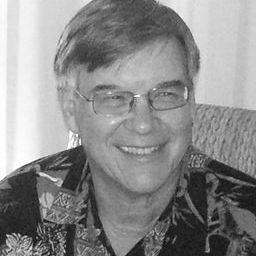
Floyd County Moonshine, LLC, 720 Christiansburg Pike, Floyd, VA 24091-
Copyright © 2008-2022 Floyd County Moonshine, LLC. All Images Copyright © Floyd County Moonshine LLC. ISSN 1946-2263

Review of Richard Nester’s Buffalo Laughter by Kathryn A. Kopple
Let us begin at the beginning: with the title poem of Richard Nester’s collection
Buffalo Laughter (Kelsay Books, 2014). In Nester’s poem, the buffalo reappear not
as the bison that once thrived on the plains of North America but buffoons—“a bunch
of old actors.” Nester draws repeatedly on popular tropes and themes throughout
his book, and in this poem he references the low-
“Every year the buffalo get
together like a bunch of old actors.
There are only enough of them
left to make a movie.”
In this compact mis-
Nester is a populist. His technique, while deft, does not distract from the message.
The poet as messenger of hardship and loss may strike us as heavy-
He shook my hand, I shook his back,
Not knowing then that I was shaking hands
With Nixon, Khrushchev, Mao Tse-
Think of it.
The act of hand-
We would like to pretend there are parts
of the body that will not lie; but hands will lie
as tongues will.
Hand as lie shows Nester at his imaginative best, making use of metonymy in unexpected
and revealing ways. The Congressman has no equal when it comes to the art of the
lie. He is the master of trickery, greasing palms, blood pacts, and washing his hands
of those who are no longer of use to him. A hand-
Unable to turn a blind eye, Nester protests: “Who could have known… I would end up a poet and pacifist?” It is a decision that costs him. Brought up to be a good Republican, a good southerner, he rebels. The schisms that divide American society disrupt his closest relationships, setting son against father, as one generation would be set against another.
Narrative poet that he is, Nester proves himself to be an accomplished story-
In “Three Sides of Narrative,” the narrator drives while listening to a recording of Levine reciting a poem in which the poet mentions a dead raccoon. Nester writes: “Just then/we pass one in the breakdown lane/lying on its side.” How to interpret this collision of verse and carnage? Nester offers the following interpretation: “It’s what we call coincidence,/two raccoons—word/and flesh…” Another phrase, “disappearing into narrative,” also causes pause; it too has a mythic air about it. Narrative is how we, as human beings, make sense of the world. We are our stories, Nester implies—narrative animals.
Indeed, Richard Nester’s debut collection, Buffalo Laughter, is the work of a poet, whose maturity, observant nature and intelligence leaves little doubt of his gifts. In poems such as “First Work,” he writes of being set the task of pulling nails to find that, with enough verve, he can produce “smoke and spark” It is there, in the heat produced by grit and words, survival and syntax, lived experience and metaphor that Nester turns anecdote into art. The tone of the poems range, as do the landscapes, and the various vernaculars heard across America condense great distances into succinct images, recollections, and meditations. I was genuinely moved by Nester’s poetry, its artistry and humanity.
Robert Nester’s poetry has appeared in numerous journals, including Ploughshares, Callaloo, Tikkun, and Floyd Country Moonshine. His work has also been anthologized in Cape Discovery, a publication of the Fine Arts Work Center in Provincetown, where he has twice been a fellow. His essays on social justice have appeared in the Catholic Agitator.
Richard Nester
Featured Author Issue 7.2 Summer 2015
In “The Study of Poetry,” Matthew Arnold uses the term “touchstone” to refer to moments in the poetry of masters that make a fundamental difference in the emotional and intellectual life of humankind. Individual poets can have “touchstones” as well, passages that they return to again and again, to set their minds and hearts in motion. There is no better way to get to know poets quickly than to know what their touchstones are.
My list is long, but here are just a few. They range from Wallace Stevens’ address
to a fictive listener in “The Idea of Order at Key West”—“oh blessed rage for order,
pale Ramon / the maker’s rage to order words of the sea”—to Dylan Thomas’ uncharacteristically
dry assertion that “hands have no tears to flow” as he concludes his assessment of
human government in “The Hand that Signed the Paper.” My heart stirs when Stevens
claims that he “placed a jar in Tennessee” or Dickinson tutors us in how to tell
the truth—“slant.” I am deeply stirred when Sasson illustrates “grace under pressure”
in his sonnet from Counter-
Thanks to Moonshine for letting me introduce myself through my poems. Two other special individuals that I want to thank are Ruth Hallman, my senior year English teacher at Floyd County High, who endorsed my immature, but intense, passion for language and Richard Dillard, the creator of the Hollins College writing program, who instructed me in tools—principally the craft of revision—that I would need to enter poetry’s grand conversation at a more mature level.
Now, for a more conventional biography, the one that appears in my book, Buffalo Laughter.
Born in the shadow of Buffalo Mountain in rural southwestern Virginia, Richard Nester has lived and worked on both coasts. Numerous journals, including Ploughshares, Callaloo, Tikkun, and Floyd County Moonshine have published his poems, and his work has been anthologized in Cape Discovery, a publication of the Fine Arts Work Center in Provincetown, where he has twice been a fellow. His essays on social justice have appeared in the Catholic Agitator.
He taught at the University of California, Irvine, for 32 years, working extensively with students from Humanities Core Course. He is married to the poet, Robbi Nester. They have a treasured son, Jeremy.
Among his other accomplishments are that he has crossed the American continent seven times, three times each by car and train, and once by bus—no covered wagon. Plane trips, of course, don’t count. The modern airplane trip is merely a mode of transport, not travel.


| Louis Gallo |
| R.T. Smith |
| Doug Ramspeck |
| Scott Hutchison |
| Mark Vogel |
| Richard Nester |
| Tim Poland |
| Casey Clabough |
| Chelsea Adams |
| Donald Secreast |
| Luke Armstrong |
| Rob Neukirch |
| Elliot Dabinsky |